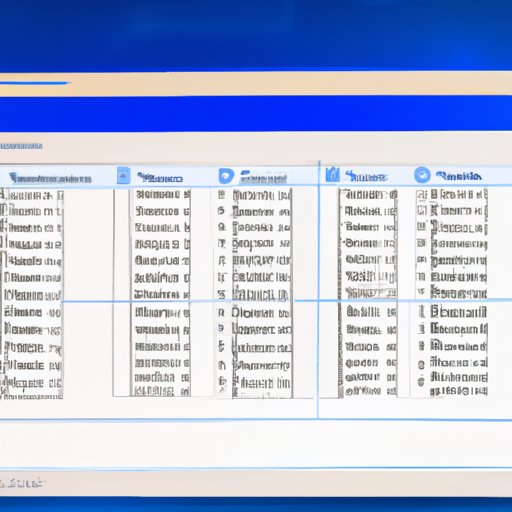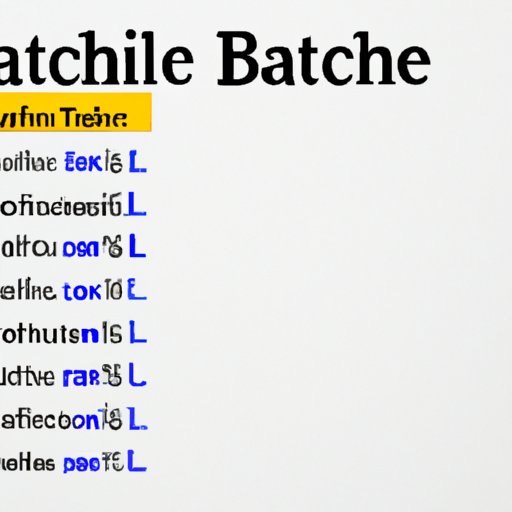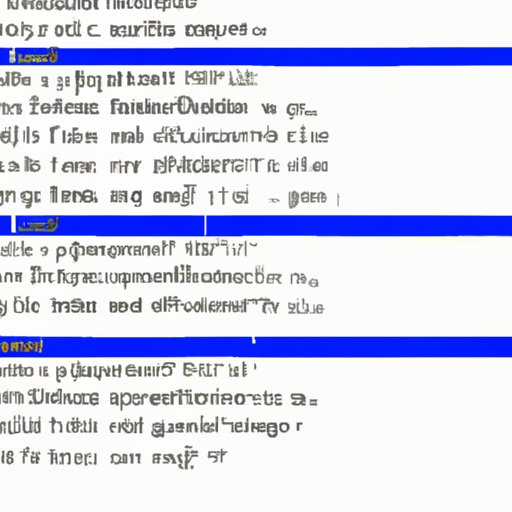Introduction
We’ve all experienced it – those tedious, time-consuming tasks that we have to do over and over again. Whether it’s backing up files or running reports, these repetitive tasks can take up valuable time and resources. Fortunately, there are ways to automate these tasks in Windows so that they can be done quickly and efficiently with minimal effort. In this article, we’ll explore how to automate repetitive tasks in Windows, from understanding the basics to exploring different approaches.
Definition of Repetitive Tasks
Repetitive tasks are any type of task that needs to be done on a regular basis. These tasks can include anything from running backups to creating reports, setting up automated emails, downloading data, or any other type of task that needs to be done repeatedly. Automating these tasks can save time and effort, as well as reduce the risk of human error.
Benefits of Automating Repetitive Tasks
Automating repetitive tasks offers a number of benefits. First, it reduces the amount of time and effort needed to complete the task, freeing up resources for other tasks. Second, it eliminates the possibility of human error, ensuring that the task is done correctly every time. Third, it can help improve efficiency, since the task can be done faster and more accurately. Finally, it can help improve customer service, since the task can be done quickly and accurately.

Utilizing the Windows Task Scheduler to Automate Repetitive Tasks
The Windows Task Scheduler is a built-in utility that can be used to schedule tasks to run at a specified time. This makes it easy to automate repetitive tasks without having to manually run them. To use the Windows Task Scheduler, follow these steps:
Overview of the Windows Task Scheduler
The Windows Task Scheduler is a built-in utility that can be used to schedule tasks to run at a specified time. It can be used to automate repetitive tasks such as backing up files, running reports, downloading data, sending emails, and more. The Windows Task Scheduler can be accessed by clicking on the Start button, typing “Task Scheduler” into the search box, and pressing Enter.
Step-by-Step Guide to Scheduling Tasks
1. Open the Task Scheduler window by clicking on the Start button, typing “Task Scheduler” into the search box, and pressing Enter.
2. Click on the “Create Basic Task” option in the Actions pane.
3. Enter a name and description for the task.
4. Select when you want the task to start.
5. Select what action you want the task to perform (e.g., open a program, send an email, etc.).
6. Specify any additional settings for the task (e.g., frequency, duration, etc.).
7. Click “Finish” to save the task.
Using Command Prompt for Automation of Repetitive Tasks
Command Prompt is a powerful tool that can be used to automate repetitive tasks. It can be used to run programs, execute commands, and perform other tasks. To use Command Prompt for automation, follow these steps:
Overview of Command Prompt
Command Prompt is a built-in utility in Windows that allows users to run programs, execute commands, and perform other tasks. It is a powerful tool that can be used to automate repetitive tasks such as backing up files, running reports, downloading data, sending emails, and more. Command Prompt can be accessed by clicking on the Start button, typing “cmd” into the search box, and pressing Enter.
Step-by-Step Guide to Using Command Prompt for Automation
1. Open the Command Prompt window by clicking on the Start button, typing “cmd” into the search box, and pressing Enter.
2. Enter the command you want to run (e.g., “dir” to list the contents of a directory).
3. Enter the parameters for the command (e.g., the name of the directory).
4. Press Enter to execute the command.
5. If necessary, repeat steps 2-4 for each additional command you want to run.

Creating and Using Batch Files for Automating Repetitive Tasks
Batch files are text files that contain a series of commands that can be used to automate repetitive tasks. They can be used to run programs, execute commands, and perform other tasks. To create and use batch files for automation, follow these steps:
Overview of Batch Files
Batch files are text files that contain a series of commands that can be used to automate repetitive tasks. They can be used to run programs, execute commands, and perform other tasks. Batch files can be created using any text editor, such as Notepad or TextEdit.
Step-by-Step Guide to Creating and Using Batch Files
1. Create a new text file using any text editor (e.g., Notepad or TextEdit).
2. Enter the commands you want to run (e.g., “dir” to list the contents of a directory).
3. Save the file with a .bat extension (e.g., “mybatchfile.bat”).
4. Double-click the batch file to run it.

Making Use of PowerShell Scripts for Automating Repetitive Tasks
PowerShell scripts are text files that contain a series of commands that can be used to automate repetitive tasks. They can be used to run programs, execute commands, and perform other tasks. To make use of PowerShell scripts for automation, follow these steps:
Overview of PowerShell Scripts
PowerShell scripts are text files that contain a series of commands that can be used to automate repetitive tasks. They can be used to run programs, execute commands, and perform other tasks. PowerShell scripts can be created using any text editor, such as Notepad or TextEdit.
Step-by-Step Guide to Writing and Running PowerShell Scripts
1. Create a new text file using any text editor (e.g., Notepad or TextEdit).
2. Enter the commands you want to run (e.g., “dir” to list the contents of a directory).
3. Save the file with a .ps1 extension (e.g., “myscript.ps1”).
4. Open the PowerShell window by clicking on the Start button, typing “powershell” into the search box, and pressing Enter.
5. Type the path to the script file into the PowerShell window and press Enter to run the script.
Taking Advantage of Third-Party Software to Automate Repetitive Tasks
Third-party software can be used to automate repetitive tasks. There are a variety of software programs available that can be used to automate tasks such as backing up files, running reports, downloading data, sending emails, and more. To make use of third-party software for automation, follow these steps:
Overview of Third-Party Software
Third-party software is any software program that is not developed by Microsoft. There are a variety of software programs available that can be used to automate tasks such as backing up files, running reports, downloading data, sending emails, and more. Before using any third-party software, make sure to check the system requirements to ensure that it is compatible with your computer.
Step-by-Step Guide to Using Third-Party Software
1. Download and install the software program you want to use.
2. Launch the program and follow the instructions to configure it for the task you want to automate.
3. Set up any additional settings for the task (e.g., frequency, duration, etc.).
4. Click “Save” or “Run” to start the task.
Leveraging Windows Keyboard Shortcuts to Automate Repetitive Tasks
Windows keyboard shortcuts can be used to automate repetitive tasks. Keyboard shortcuts allow users to quickly and easily perform tasks such as opening programs, launching websites, copying and pasting text, and more. To make use of Windows keyboard shortcuts for automation, follow these steps:
Overview of Keyboard Shortcuts
Windows keyboard shortcuts are combinations of keys that can be used to quickly and easily perform tasks such as opening programs, launching websites, copying and pasting text, and more. Keyboard shortcuts are a great way to save time when performing repetitive tasks, as they can be used to quickly access programs and functions without having to search for them.
Step-by-Step Guide to Using Keyboard Shortcuts
1. Identify the task you want to automate.
2. Look up the keyboard shortcut for the task (e.g., Ctrl+C for copy and Ctrl+V for paste).
3. Press the appropriate keys to execute the shortcut.
Conclusion
Automating repetitive tasks in Windows can save time and effort, as well as reduce the risk of human error. In this article, we explored how to automate repetitive tasks in Windows, from understanding the basics to exploring different approaches. We looked at how to utilize the Windows Task Scheduler, use Command Prompt, create and use batch files, make use of PowerShell scripts, take advantage of third-party software, and leverage Windows keyboard shortcuts to automate repetitive tasks. With the right approach, you can automate your repetitive tasks and free up time for other tasks.
Summary of the Article
In this article, we explored how to automate repetitive tasks in Windows, from understanding the basics to exploring different approaches. We looked at how to utilize the Windows Task Scheduler, use Command Prompt, create and use batch files, make use of PowerShell scripts, take advantage of third-party software, and leverage Windows keyboard shortcuts to automate repetitive tasks. With the right approach, you can automate your repetitive tasks and free up time for other tasks.
Final Thoughts on Automating Repetitive Tasks in Windows
Automating repetitive tasks in Windows can save time and effort, as well as reduce the risk of human error. By utilizing the Windows Task Scheduler, using Command Prompt, creating and using batch files, making use of PowerShell scripts, taking advantage of third-party software, and leveraging Windows keyboard shortcuts, you can automate your repetitive tasks and free up time for other tasks.
(Note: Is this article not meeting your expectations? Do you have knowledge or insights to share? Unlock new opportunities and expand your reach by joining our authors team. Click Registration to join us and share your expertise with our readers.)
